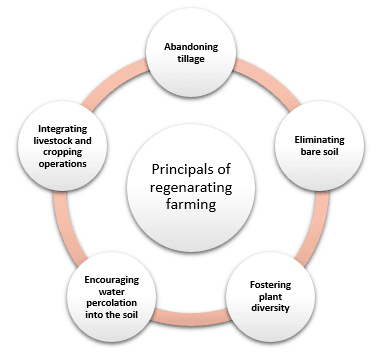Regenerative Agriculture: Transforming Food Production for a Sustainable Future
Regenerative agriculture is an alternate means of producing food, making an effort to reduce their reliance on synthetic inputs such as herbicides, pesticides, and chemical fertilizers. Its emergence is a result of the negative impacts of intensive farming methods, which include the use of heavy machinery, fertilizers, and pesticides with the main focus of maximizing food production.
Regenerative agriculture is a conservation and rehabilitation approach with the focus on soil regeneration, supporting bio-sequestration, improving water cycles, tackling climate change.
Regenerative farming also differs from organic farming although many principles overlap among them. Organic farming has emerged as a trusted brand and has clear standards and regulations, but regenerative farming is a growing movement with varying definitions and minimal regulations. Both of these methods are seen as alternatives to intensive farming and are believed to strengthen each other.

Techniques used in Regenerative agriculture
Cover cropping– Continual plant growth and root growth in the soil is essential for regenerative agriculture. The aim here is to remove CO2 from the atmosphere, sequestering carbon as organic matter within the soil, that promotes soil biology, provides nutrients to the soil, and reduces soil erosion
Composting– Biological materials such as crop residue, food waste, and animal waste are used to build soil organic material. Composting accelerates the decomposition of these materials, creating compost material for soil microbes and plants to utilize
Silvopasture– It is the integration of livestock grazing and trees on the same land. Perennial crops are planted between the trees. These crops don’t require to be replanted each year and are more permanent in nature. Animals feed on these perennial forage crops and take shelter beneath the trees. This provides support to both animals and land from wind and water erosion
Managed Grazing– In managed grazing, divisions of a forage field are created using fences. Animals are then shifted between divisions periodically to allow and re-growth of a division prior to animal rotation. This practice reduces soil erosion, improves water penetration, and provides quality livestock nutrition
Managed grazing reduces the amount of fertilizer needed to grow an acre of land. As per a study conducted by USDA Agricultural research service, grazing operations reduced sediment erosion by 87%, reduced phosphorus runoff by 5.5 kg per acre and lowered ammonia emissions by 30%
Need for Regenerative agriculture
In 2014, the UN Food and Agriculture Organisation announced that if the current soil degradation rate continues to go unchecked, all topsoil will be depleted within 60 years. As per the United Nations, agriculture is responsible for over a third of greenhouse gas emissions released globally. Intensive farming through tilling releases CO2 naturally stored in the soil and disrupts soil structure, accelerating soil erosion, leaving the environment more vulnerable to extreme weather events like flooding
Conclusion
The high carbon footprint of intensive farming and its long-term negative impact on the land have made it necessary to adopt alternate methods of farming. Two of the options available are regenerative agriculture and organic farming. Both of these could be used complementarily as a solution to this problem. Methods adopted in regenerative agriculture have resulted in positive outcomes, as has been shown through numerous studies.
In comparison with intensive farming, research has shown that crop yields obtained are lower, but vary greatly depending on the crop and local locations. Another challenge in the adoption of regenerative agriculture is lack of knowledge and skills at the moment among farmers.
Benefits of regenerative agriculture are that it requires lower input costs and attracts higher prices than conventional produce. It will encourage farmers to upskill and gain the requisite knowledge to adopt this alternate method of farming.
Author: Abhishek Saini
